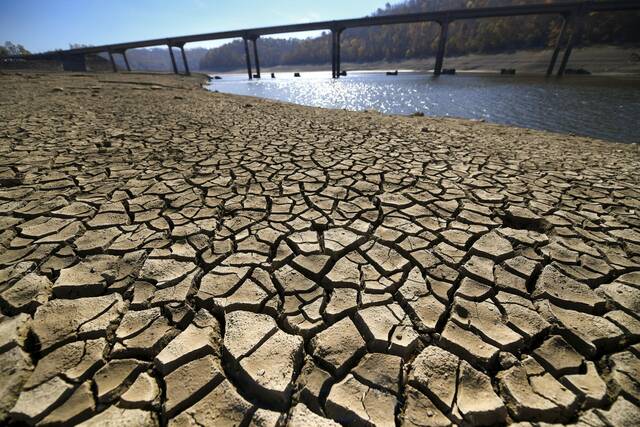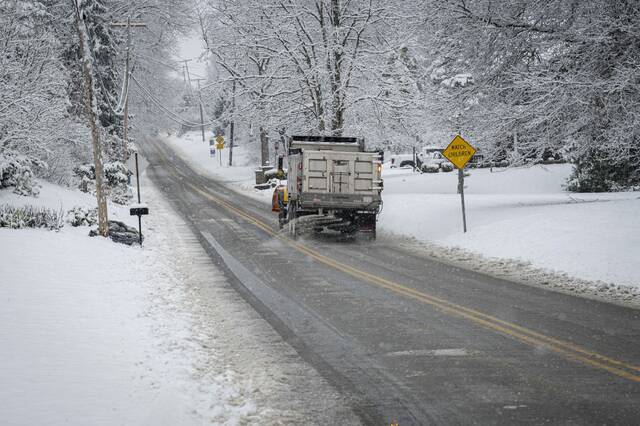Jim Bonner used to associate mockingbirds with the southern part of the United States.
His backyard is home to one, it’s indicative of how weather changes have impacted the avian species, and likely will continue for other types of birds.
“I see more mockingbirds now that I ever did 20 years ago,” said Bonner, executive director of the Audubon Society of Western Pennsylvania. “Their range has continued to expand northward.”
Birds that make their homes in backyards across the region are likely to be affected by the ongoing warming of the planet as a result of climate change. On Friday, several weather monitoring agencies announced 2024 was Earth’s hottest year ever, the Associated Press reported.
The National Weather Service in Moon reported this month that 2024 was the warmest year on record for the Pittsburgh region with an average mean temperature of 56.4 degrees The previous record was set in 1921 at 55.4 degrees.
Over the next 25 years, climate change is predicted to affect many aspects of daily life for Pennsylvanians. Among those predictions are:
• It’s going to be warmer — the average temperature in Pennsylvania is expected to increase by nearly 6 degrees by 2050 and the number of 90-degree days will rise, according to the state Department of Environmental Protection’s Climate Impacts Assessment for 2021. Heat waves are expected to become increasingly common and the time of year when weather can be warm may bleed into spring and fall, reducing the amount of time without frost, according to Community Climate Outlook assessments spearheaded by a partnership led by the National Oceanic and Atmospheric Administration.
By 2070, Westmoreland County could see an average of 10 to 24 days above 95 degrees, while Allegheny County could expect 13 to 30 days above that benchmark per year, according to the assessments.
• It’s going to be wetter — the average annual precipitation could increase by 8%, the state assessment says, predicting heavier precipitation events, which could increase risks for flooding and other disasters, such as landslides and sinkholes.
The changes experts expect for Pennsylvania through the next couple decades could have impacts on public health, agriculture, recreation, wildlife, forests and infrastructure, among others. But some of those changes are already being felt, experts said.
“We’re seeing increased extremes, there’s no doubt about that,” said Brett Anderson, a senior meteorologist at AccuWeather. “Climate change is going to affect everybody in many ways.”
That impact has the potential to hit wallets, too. A July 2023 study by the Center for Climate Integrity found that Pennsylvania’s municipal governments will have to spend at least $15.47 billion by 2040 to protect residents. Those costs would include installing air conditioning in schools, boosting storm drainage capacity and increasing road maintenance.
The study estimated the City of Pittsburgh would be facing $31 million in annual adaptation costs while Hempfield, Westmoreland County’s largest municipality, would have to spend about $9.6 million every year until 2040.
During Anderson’s 35 years as a meteorologist, he said he’s seen the average snowfall decrease and the peak season for fall foliage be pushed back by about a week or so. He thinks it’s possible climate change played a role in a widespread drought earlier this year that spanned three states, including Pennsylvania. Some parts of Southwestern Pennsylvania remain in a drought watch.
Average temperatures at night have been increasing faster than those during the day — 0.7 degrees compared to 0.4 degrees — between 2000 and 2020, according to the state climate assessment.
“In terms of the majority of the warming that we’re going to see in the coming decades, most of that is going to be felt at night,” Anderson said.
He explained that there will be more cloud cover and moisture to act as a blanket at night, holding the heat close to the ground. Cold nights can be beneficial for some crops, like apples and maple syrup, and the seasonal elimination of ticks and insects.
A warmer climate, especially at night, can cause stress to the environment, wildlife, humans, trees and plants, said Erica Smithwick, director of the Penn State Climate Consortium and the university’s Earth and Environmental Systems Institute.
“When things don’t cool down at night, there are significant health risks,” she said. “The night is really important for a cooling off period.”
In a state where there was 16.2 million acres of forested land in 2020, Smithwick said that expanse of trees could be exposed to more pests, pathogens and invasive species that may use the warmer temperatures as a means to expand their ranges. About 70% of trees in Pennsylvania are between 80 and 120 years old.
Impacts to trees could mean their ability to absorb carbon dioxide may decrease and certain tree species that prefer cooler weather and produce brilliant fall leaves, like sugar maple, beech and birch, could disappear locally.
Air pollution could become exacerbated with warmer temperatures, which would impact vulnerable people, she said, pointing to mid-2023 when the region was inundated with smoke from wildfires in Canada. The air was at unhealthy pollution levels for everyone at one point then. In instances like that, the impact on social systems can increase, Smithwick said.
“The stress on the health care system are likely to become pretty high, more exacerbated, due to these effects,” she said.
Western Pennsylvania Conservancy researchers have since 2014 been taking a close look at peatlands, a type of specialized habitat wetland that prefers cooler weather. They are documenting species found in those unique environments to lay a groundwork for the future, said Jeffrey Wagner, the conservancy’s senior director of the Pennsylvania Natural Heritage Program.
“You might lose 20% of the species that are there now,” he said.
Weather-related changes in an ecosystem can have broad impacts — some native plants, or those that need a unique habitat, may bloom earlier or be unable to compete with others that have found ways to withstand a different environment, he said. That could have a ripple effect for insects, birds, moths, butterflies and animals.
“If you change the amount of precipitation relative to those communities, those can affect those plants,” Wagner said. “If competition increases, those plants succumb.”
The birds Pennsylvanians are used to seeing, whether they be year-round residents or migratory, might change as a result of environmental impacts, Bonner said. If they can’t find the seed, berry, nectar, insect or habitat here essential to their survival, birds with specific needs may make their home elsewhere.
“Things get out of sync,” Bonner said, adding that birds that are more generalists will have a better ability to adapt.
Avian species that are typically found in warmer climates may move north into the area, while those whose homes are typically farther north of Pittsburgh may not come around anymore, he said. And it’s not just the temperature — heavy rains can wash away nests, and possibly eggs or young, in the ground or trees.
The Western Pennsylvania Conservancy has been working on revegetation and tree planting, while selecting, and seeking out, properties that have a variety of topography and elevation to give species an opportunity to move to a more hospitable location. It’s a way the organization can help provide what flora and fauna need to survive.
“If plants and animals are stressed in their habitat because of climate change, they’re going to move to someplace where it is less stressful,” Wagner said. “It’s a conscious thing to keep building on these public lands to give that advantage.”








